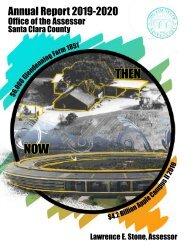Annual Report 2020 -2021
Annual Report 2020 -2021 Santa Clara County
Annual Report 2020 -2021 Santa Clara County
Create successful ePaper yourself
Turn your PDF publications into a flip-book with our unique Google optimized e-Paper software.
What Are Supplemental Assessments?
Supplemental assessments were created
by Senate Bill 813 in 1983 to close
what were perceived as loopholes
and inequities in Proposition 13.
Total
supplemental taxes
collected in 2019-20
was $143.73 million; a 15
percent decline and an early
indicator that the economy
was in flux.
Prior to the creation of supplemental
assessments, changes
in assessed value due to a
change in ownership or completion
of new construction
would not result in higher
taxes until the tax year (July
1 to June 30) following the
lien date when the new values
were placed on the assessment
roll. In some instances, taxes on
the new assessments would not be
collected for up to 21 months. This
resulted in serious differences in tax treatment
for transactions that may have only been separated by
one day. It also created a substantial amount of new
revenue for schools and local government. Supplemental
assessments are designed to identify changes
in assessed value (either increases or decreases) that
occur during the fiscal year, including changes in
ownership and new construction. They are in addition
to the traditional annual assessment and property tax
bill. A tax bill is issued only on the added value, and
is prorated for the remaining portion of the fiscal year.
For the next fiscal year, the entire new assessed value
of the real property is added to the regular assessment
roll. The increase in value is taxed from the first day
of the month following the date of completion of new
construction or change in ownership.
The Assessor’s Office produces a supplemental roll
that generates significant revenue not part of the annual
assessment roll. The assessed value of all supplemental
assessments for the calendar year 2019 totaled
$13.7 billion, a dramatic decline from the prior
year total of $19.4 billion. Similarly the number
of transactions also declined 43 percent.
Supplemental assessments are processed
daily, unlike the annual assessment roll.
Supplemental assessment data is a useful
indicator of current trends in the real estate
market. During the first six months of 2020,
compared to the same period last year, the
number of transactions and total supplemental
assessed value increased 34 percent and 36
percent respectively, yet the average value per
supplemental assessment increased 2 percent. While
supplemental assessments were processed during the
Covid-19 shelter in place order, the actual transactions
likely occurred months earlier.
The chart below reflects the number of supplemental assessments
processed, and the average assessed value per
transaction for each calendar year.
Supplemental Assessments
35,000
$792,377 $808,178
$900,000
30,000
25,000
$638,982
$653,367
$593,169
$425,038
$800,000
$700,000
$600,000
20,000
$500,000
15,000
10,000
5,000
0
$291,319
31,283 29,096 25,127 24,200 27,269 24,494 17,016
2013 2014 2015 2016 2017 2018 2019
$400,000
$300,000
$200,000
$100,000
$0
Number of Supplemental Assessments
Average Assessed Value per
Supplemental Assessments
8
Santa Clara County Annual Report 2020




